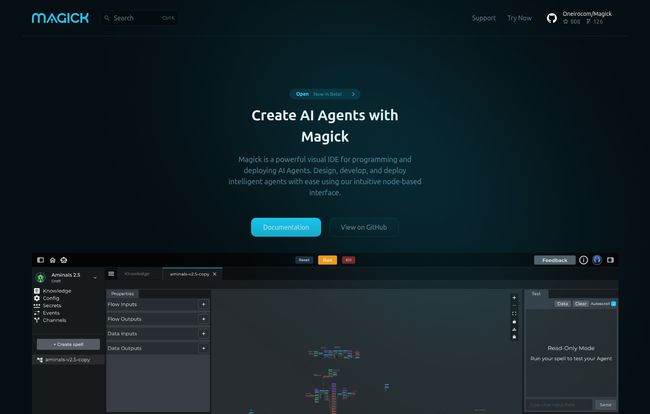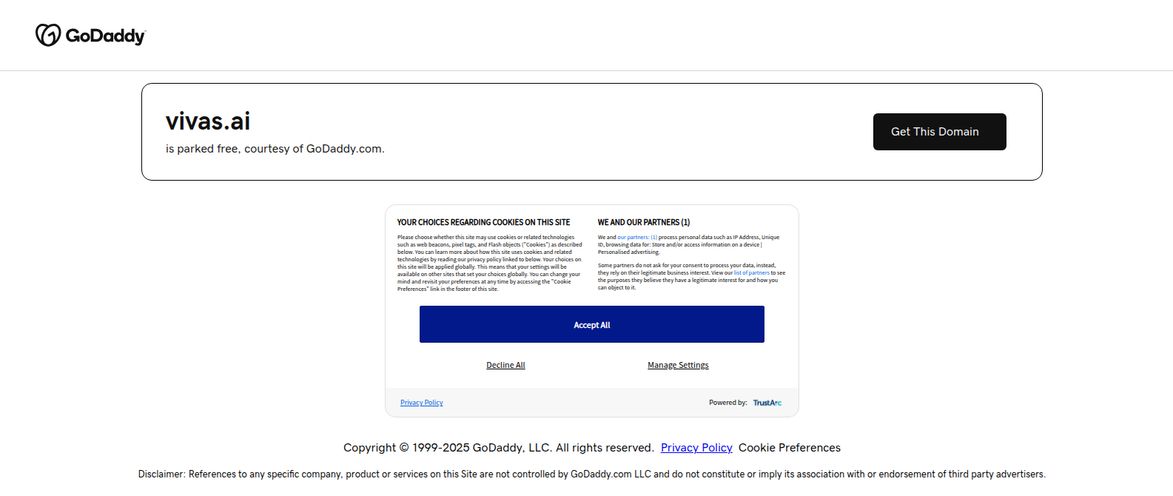The AI gold rush is in full swing. Every other person I grab coffee with has an idea for the “next big AI app.” And I get it! The excitement is palpable. But then comes the reality check: building this stuff is… hard. You’re wrestling with APIs, managing infrastructure, debugging Python scripts at 2 AM, and wondering if you should’ve just become a baker instead.
For years, I've watched platforms promise to simplify development. Some are great, others are just lipstick on a pig. So when I stumbled across Magick, a platform that calls itself a “visual IDE for programming and deploying AI Agents,” my professional curiosity (and a healthy dose of skepticism) kicked in. A visual builder for AI? It sounded like either the future or another overhyped tool. So, I rolled up my sleeves to find out.
So, What on Earth is Magick AI?
Imagine you're building with digital LEGOs. Instead of writing line after line of code, you grab a block—one for processing text, one for calling an LLM like GPT-4, another for pulling data from a document—and you snap them together. That’s the core idea behind Magick. It’s a low-code, node-based environment where you visually map out the logic of your AI application.
You’re not just typing commands into a black screen; you’re orchestrating a flow, connecting inputs to outputs, and watching your agent come to life in real-time. This approach immediately lowers the barrier to entry. You don’t need to be a coding wizard to start building, but as we’ll see, having some technical savvy still helps. Plus, the fact that its open-source is a massive green flag for me. It means a community can build on it, inspect it, and you're not entirely locked into one company's ecosystem.
The Visual Node Builder: Your AI Command Center
Okay, the centerpiece of Magick is its visual editor. The first time you see it, it can be a little…intimidating. It looks less like a simple web form and more like the control panel for a spaceship or a professional video editing suite. You've got nodes, wires, and panels everywhere.

Visit Magick
But once you spend a few minutes with it, something clicks. Each node is a specific function. You might have a “String Processor” node, an “LLM” node, and an “Output” node. You drag a virtual wire from the output of one to the input of the next. It’s a beautifully logical way to represent what’s happening under the hood. For visual thinkers like me, its a revelation. Instead of trying to hold a complex chain of command in my head, I can see it laid out right in front of me. It makes debugging a whole lot more intuitive, too—you can literally see where the data flow breaks.
Key Features That Actually Matter
A lot of platforms throw a kitchen sink of features at you, but only a few are genuine game-changers. Here’s what stood out to me in Magick.
Bring Your Own Brain (Platform Agnostic LLMs)
This is huge. Magick isn’t trying to lock you into a single large language model. The documentation and interface make it clear you can plug in heavy hitters like OpenAI’s GPT-4 or Anthropic’s Claude, but you can also connect to open-source alternatives. This flexibility is critical. Maybe today, GPT-4 is the best for your task. Tomorrow, a new open-source model might be cheaper and faster. With Magick, you can just swap out the “brain” of your agent without rebuilding the entire thing. For any startup or developer watching their budget, this is a non-negotiable feature.
Test Ideas at the Speed of Thought
One of the biggest drags in development is the cycle of code, compile, test, fail, repeat. Magick’s real-time testing and rapid prototyping capabilities slash that time dramatically. You can tweak a prompt, change a variable, or rewire a connection and see the result instantly in a test window. This turns the development process from a chore into a creative exploration. You can ask “what if…?” and get an answer in seconds, not minutes. This is how you stumble upon those happy accidents and innovative solutions.
Beyond Basic Chatbots
While you can certainly build a chatbot, Magick's power goes deeper. It has robust tools for Powerful Document Processing, which is the backbone of any serious Retrieval-Augmented Generation (RAG) application. You can feed it PDFs, text files, or other documents, and it can extract, embed, and search that knowledge to provide context-aware answers. It also boasts Multi-Platform Integrations, so you can easily connect your AI agent to services like Discord, Telegram, or even custom webhooks. This means the agents you build can live where your users are, not just on a standalone webpage.
The Good, The Bad, and The Node-y
No tool is perfect, right? After spending time with Magick, I have a pretty clear picture of its strengths and where you might hit a snag.
On the bright side, the open-source nature combined with its LLM flexibility is a winning combination. The speed of prototyping is addictive, and for anyone who isn't a senior backend engineer, it makes building complex agents surprisingly accessible. You can get an MVP off the ground in a weekend, not a quarter. The community on Discord seems active, which is always a good sign for an open-source project.
Now for the potential hiccups. That node-based interface, while powerful, has a learning curve. If you’re expecting a simple drag-and-drop website builder, you’ll be in for a shock. It requires a certain mindset to get the hang of it. Also, while it gives you incredible power, you are somewhat reliant on the nodes and integrations available. If you need a super-niche function that doesn't have a pre-built node, you might have to get your hands dirty with some custom development. Finally, you’re depending on the Magick architecture for deployment and scaling. For most, this is a huge plus (no server management!), but for large enterprises with specific infrastructure requirements, it could be a point of friction.
The Million-Dollar Question: What’s the Price Tag?
So, what's the damage to your wallet? I wish I had a simple answer. In a moment of true real-world user experience, I went looking for the pricing page, and… I was met with a 404 Not Found page. Oops.
However, the homepage does mention “Metered Billing,” which gives us a pretty good clue. This typically means a pay-as-you-go model. You’re not paying a flat, hefty monthly fee, but rather for what you actually use—things like processing time, the number of agent interactions, or data storage. Personally, I’m a fan of this model. It means you can start small and the costs scale with your success. It’s fair and transparent. I'm guessing they are either updating their pricing tiers or are focused on the self-hosted open-source version for now. I'd recommend keeping an eye on their site or jumping into their Discord for the latest info.
My Final Verdict: Is Magick the Real Deal?
After diving in, I can say Magick is much more than just another tool in the crowded AI space. It's a genuinely powerful and well-thought-out platform that successfully bridges the gap between complex coding and simple UI builders. It strikes a fantastic balance, offering enough depth for serious developers while remaining approachable for ambitious creators with less technical backgrounds.
Is it a magic wand that will build your entire AI empire with one click? No. You still need to bring the logic, the creativity, and the strategy. But Magick provides an incredible spellbook and a wand that’s a hell of a lot easier to wield than raw code. For anyone serious about building AI agents without the traditional overhead, Magick is absolutely worth a look. It feels like a glimpse into a future where creating AI is less about boilerplate code and more about pure imagination.
Frequently Asked Questions about Magick
What is Magick AI, in simple terms?
Magick AI is a visual tool that lets you build AI applications, called agents, by connecting blocks (nodes) together instead of writing lots of code. It's designed to make AI development faster and more accessible.
Is Magick a good tool for beginners?
It's more accessible than traditional coding, for sure. A beginner who is technically inclined and willing to learn the node-based system can definitely use it. However, someone with zero technical background might find the interface a bit complex at first.
What AI models can I use with Magick?
Magick is platform-agnostic, meaning you can integrate a wide variety of Large Language Models (LLMs). This includes popular ones like GPT-4 and Claude, as well as various open-source models, giving you a lot of flexibility.
Is Magick completely free to use?
Magick is an open-source project, so you can self-host and use the software yourself. For their managed platform, they mention a "Metered Billing" model, which means you pay for what you use. The exact pricing details weren't available at the time of this review.
Can I deploy real applications with Magick?
Yes. Magick is built for the entire development lifecycle, from prototyping to scalable deployment. You can build agents and integrate them into various platforms like websites, Discord, and more for real-world use.
How is Magick different from tools like LangChain?
LangChain is a code-based framework (a library for Python/JS), requiring you to write code to chain AI components together. Magick accomplishes a similar goal but through a visual, low-code interface. Think of Magick as a visual layer on top of the concepts that libraries like LangChain popularised.
Reference and Sources
- Magick Official Website: https://www.magick.cloud/
- Magick GitHub Repository: https://github.com/oneirocom/magick



